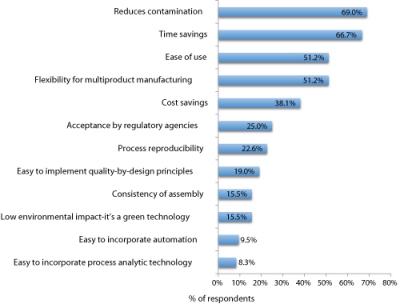
Hybrid equipment dominates
Hybrid manufacturing systems, which feature traditional stainless steel and disposable, single-use equipment, were used by almost three-quarters (74.4%) of the respondents; 16.3% use all stainless; 9.5% use all disposable.
All respondents, those who used and did not use disposables, shared perceptions about the value of single-use systems. Nearly 70% cited reduced contamination as an advantage. Time savings, ease of use, and flexibility for multiproduct manufacturing were identified as advantages by more that half of the respondents (Figure 1). While 38.1% said disposables offered cost savings, 55.6% said high cost was a challenge to using a disposable system. Other challenges were limitations on size and leaching of the disposable material into the product (Figure 2).
Quality by Design
Improved process understanding (68.4%), improved product quality (66.7%), and reduced variability in product quality (57.9%) were the top advantages identified by the respondents who have implemented quality-by-design (QbD) principles in their biopharmaceutical manufacturing operations. Nearly half reported improved manufacturing efficiency as a result. However, almost 32% of the respondents have not implemented QbD. Reasons cited for not implementing QbD include a lack of guidance and direction from regulatory agencies (46.2%), no process or quality advantage to be gained (30.8%), a lack of understanding of the QbD initiative (23.2%), or it is too costly.
Past and future innovation
Respondents revealed insight about recent innovations that have improved process efficiencies. Equipment and products related to disposable systems were most frequently mentioned.
There is, however, room for improvement. Better disposable systems, including bags that do not leak, reduced leaching, larger bioreactors and fermenters, and disposable sensors were identified as desired new technologies to improve process efficiencies. Better filtration, chromatography columns, automation, and process analytical technologies also were identified as ways to improve manufacturing efficiencies.
an Alternative:
Outsourced Manufacturing
Outsourced manufacturing plays a prominent role among the companies represented in the survey. Almost 40% reported outsourcing of some component of biopharmaceutical manufacturing. Leading outsourced function, are drug substance manufacturing, API and finished products manufacturing, and clinical trial-materials manufacturing. More than one-third of the companies outsource full-scale commercial manufacturing. Limited internal manufacturing capabilities and cost-effectiveness were the leading reasons cited for outsourcing different functions in biopharmaceutical manufacturing.
Reference
1. BioPharm International Manufacturing Trends 2014 Survey.